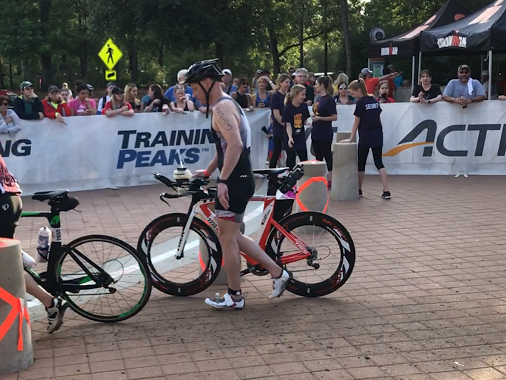Father inspires with yearly Ironman accomplishments
“Jared Graening, you are an Ironman!” My dad has heard these words four times in his life. Three of the time I’ve witnessed them being said.
On April 22, my dad, Jared Graening, completed his fourth Ironman. He finished the Memorial Hermann Ironman Texas North American Championship in the top third of all of the finishers. My dad went from not knowing how to swim to completing his first Ironman in just two years. He took on the ultimate challenge and learned a lot about himself in 12 hours.
The W is a recreational center in Waverly that opened around nine years ago. Graening bought a membership and started to train.
“When the W opened, I was inspired to start doing triathlons,” he said. “The reason the opening of the W inspired me was because I already knew how to bike, and I knew how to run, but I didn’t know how to swim.”
With the opening of the W came the opening of an indoor pool in Waverly. Graening used this to his advantage. As soon as swimming became accessible to Graening, he worked on this skill. “I learned how to swim, and I said to myself, ‘Wow, I could do a triathlon.’”
Graening has done two olympic distance triathlons, two half Ironmans and four full Ironmans. In an olympic distance triathlon, the participant swims about a mile, bikes 24.8 miles and runs 6.2 miles. In an Ironman, the participant swims 2.4 miles, bikes 112 miles and runs a marathon.
Since the Ironman race is so demanding, Graening has a training schedule that he starts to intensify 14 weeks before the race.
“I train up to 14 hours a week. I swim two hours a week. I bike eight-10 hours a week, and then I run the rest,” he said.
With the nicer weather, Graening was able to do some of his training, like running and biking outside.
“I start to ramp up my training before an Ironman typically about 14 weeks before the event.”
When Graening is not preparing for a race, he works out five-seven hours per week.
“When I’m training on the weekends, my long work out might be a five-hour bike ride on a Saturday, and then maybe a one hour run and swim on Sunday. The following week, I might do a long run and not as long as a bike workout.”
Graening added that even though he uses the same muscles in his legs running and biking, he works them out differently.
“I have the most difficulty with running. I have a hip flexor, and, overall, I’m not a very strong runner.”
Although Graening isn’t a strong runner, he makes up for his running time with his bike time.
“I’m a strong biker, and this year I had a personal best with my time,” he said.
Graening’s overall bike time was 5:29.
“I would love to continue doing Ironmans,” he said; however, family commitments and work commitments are hard to plan around.
“The day before the race I checked my bike in at the bike center, and I did a swim in the water, and that was about it. I took it easy,” he said.
It’s seems unimportant, but Graening said it’s essential to be familiar with the area he will be racing in. Getting a feel for the lake before the race is always a good idea, and then he gets in a pre-race meal. “The day before I usually eat an omelette or chicken and rice,” he said.
Because Graening is constantly moving for over 12 hours, it’s important that he stays hydrated and puts nutrients in his body.
“During the race I use nutritional supplements — stuff like GU energy gels or Cliff Bars, this time I used a blended supplement throughout the race.”
The drink contained potassium, sodium, magnesium and other nutrients that helped him finish strong.
“I’m always nervous before the race. The swim start is always unnerving. When you’re swimming in a pool, you can always see the line on the bottom,” he said.
The Ironman begins in the early hours of the morning, so the water is very dark and murky. The swimming start is always hectic.
“You’re starting with 2,800 people, and everyone’s fighting for positions,” he said.
Graening said that it is extremely important during this time to stay calm. “Taking deep breaths is essential. Keeping your heart rate under control is essential. Once the race is going, I’m fine,” he said.
Even though the swim start is always a nail-biting time, before the start is always one of Graening’s favorites parts.
“I love the nervousness of it,” he said. “I love trying to make myself be calm and just stay relaxed. The anticipation and build up a week before the race is also something I struggle with. It’s probably the worst for me.”
During the race, however, Graening said it’s not hard to stay motivated. The adrenaline helps him stay motivated.
“There’s lots of people cheering you on and supporting you, and there’s lots of music playing,” he said.
People watch all legs of the race — the swim, the bike and the run, so there’s someone cheering athletes on every step of the way till the finish line.
“I feel happy I finished, but there’s also a sense of a let down because you’ve trained for so long, and you want to get to it so bad. Once you’re done, you kind of just say, ‘Now what,’” he said. “Mentally you look at it and say, ‘Now what am I going to do.’”
Graening said these feelings usually go away after a day or so. “My final time was 12:21, which was exactly an hour better than it was my first time doing an Ironman.”
Graening has shed minutes off of his final time each time completing an Ironman. Not everyone will complete an ultimate endurance race, but Graening’s advice can be applied to people with any fitness goal.
“My advice to people that want to get into shape is to set goals and be disciplined,” he said.











You must be logged in to post a comment Login